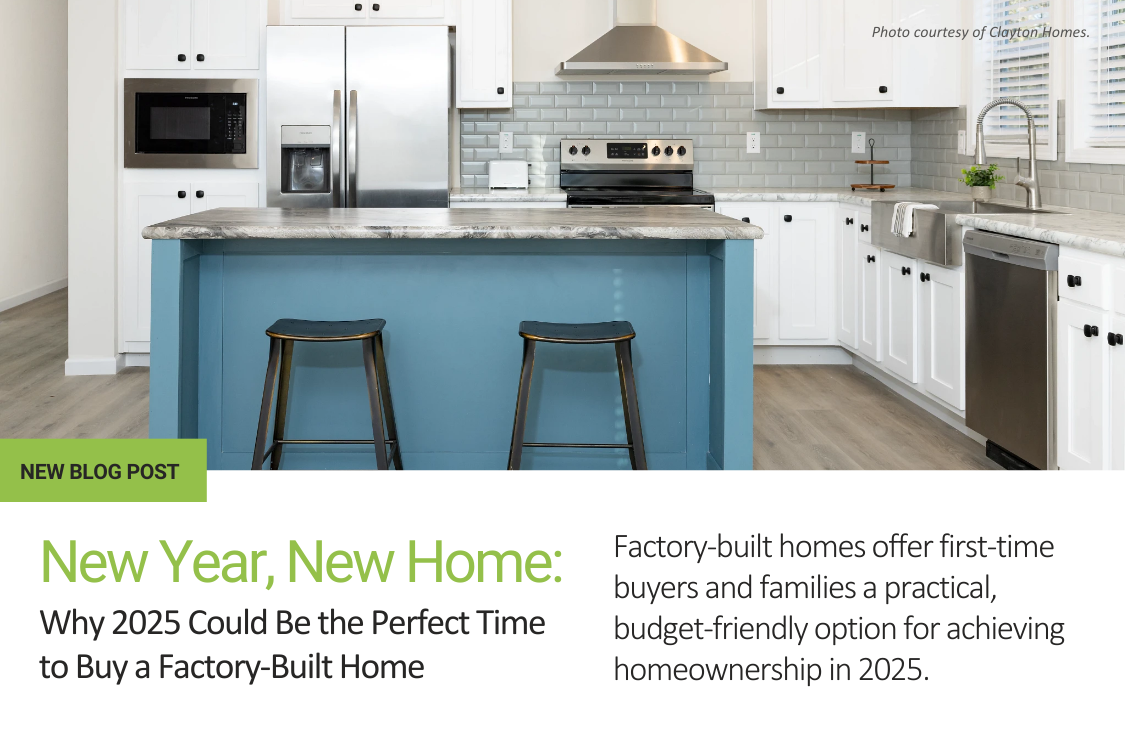The New Year is the perfect time to set goals and make plans for the future. For many, homeownership might feel out of reach with inflation and record home prices dominating the headlines. But here’s some good news: factory-built homes are helping more families turn their dream of owning a home into reality.
A factory-built home is constructed in a controlled environment, transported to your site, and placed on a permanent foundation. This efficient process allows builders to save on costs, reduce waste, and avoid weather delays—all of which translate to a more affordable path to homeownership.
What Makes Factory-Built Housing a Smart Choice for 2025
Factory-built homes offer first-time buyers and families a practical, budget-friendly option for achieving homeownership. Let’s explore why they’re a great choice this year.
An Attainable Homeownership Option
Did you know that factory-built homes are typically 30-50% less expensive per square foot than site-built homes? The median price of a new single-section factory-built home is around $90,000—a far cry from the $400,000 price tag of many site-built homes. Even when you factor in the cost of land, the savings are substantial. Plus, purchasing a factory-built home on owned land allows you to build equity and grow your wealth over time.
Energy-Efficient Construction
Factory-built homes are designed with energy efficiency in mind. All homes comply with strict HUD Code standards, and many meet ENERGY STAR® certification, cutting energy bills by up to 30% compared to uncertified homes. Some builders even offer Zero Energy Ready packages, giving homeowners the opportunity to eliminate power bills entirely. Key features include:
- Enhanced Insulation
- Solar-Ready Construction
- High-Efficiency Heating & Cooling Systems
Learn more about energy-efficient factory-built homes here.
Modern Designs & Features
Forget the outdated stereotypes of mobile homes. Today’s factory-built homes feature open floor plans, high ceilings, and modern finishes that rival site-built homes. Buyers can also customize layouts, finishes, and features like smart home technology and energy-efficient appliances, creating a home that’s uniquely theirs.
Financial Advantages for Homebuyers
Factory-built housing offers significant financial benefits, making it an excellent choice for budget-conscious buyers seeking long-term value.
Access to Special Mortgage Financing
Programs like Fannie Mae’s MH Advantage® and Freddie Mac’s CHOICEHome® offer competitive loan terms similar to those for site-built homes. Benefits include:
- Down payments as low as 3%
- Fixed interest rates comparable to site-built mortgages
- The option to include land purchase costs
These programs are designed to make factory-built homes accessible and affordable, with features like higher-pitched roofs, attached garages, and upgraded interiors and exteriors.
Learn more about financing factory-built homes here.
Tax Incentives & Grants
Homebuyers can also take advantage of tax incentives and grants to offset costs and increase long-term savings. Current opportunities include:
- Federal Residential Clean Energy Credit: A 30% tax credit for renewable energy systems like solar panels, available through 2032.
- State-Level Incentives: Rebates or credits for energy-efficient upgrades such as heat pumps or weatherization improvements.
- Nonprofit & Local Grants: Organizations like Habitat for Humanity may offer grants or low-interest loans for energy-efficient housing solutions.
Build Equity
Buying a factory-built home is more than an affordable housing option—it’s an investment in your future. When placed on a permanent foundation on owned land, these homes appreciate in value similarly to site-built homes. In fact, from 2016 to 2021, factory-built home values rose by an average of 34.58%, nearly matching the 35.44% increase seen in single-family homes.
In 2015, Robert and Chasity purchased a Clayton-built home and land parcel outside of Asheville, North Carolina. Clayton and Next Step recently revisited the Woody family and learned how their home has become an investment in their family’s lives and future.
“When we first purchased our home [in 2015], it was around $179,000. They did an appraisal just a couple weeks back and it ended up appraising for around $320,000.”
– Robert Woody in July 2022
Addressing Common Concerns
Potential buyers often have questions about factory-built housing. Let’s tackle some common concerns:
Material & Construction Quality
Factory-built homes are crafted in climate-controlled facilities using high-quality materials and precise techniques. This controlled environment ensures consistent craftsmanship and protects materials from weather damage. These homes are built to meet or exceed the strict HUD Code standards for safety, energy efficiency, and structural integrity—making them as reliable as site-built homes.
Long-Term Durability & Climate Resiliency
Modern factory-built homes are designed to last for decades and withstand various environmental challenges. In hurricane-prone areas, for example, many homes are built to endure winds of up to 160 mph. With available upgrades for energy efficiency and weatherization, factory-built homes are not only durable but also climate-resilient.
Learn more about climate-resilient factory-built homes here.
Resale Value & Wealth-Building
A common misconception is that factory-built homes don’t hold their value. However, when placed on a permanent foundation with owned land, these homes appreciate in value just like site-built homes. Modern designs, energy certifications, and high-quality construction further enhance resale value, making them a solid long-term investment.
Affordable, energy-efficient, and packed with modern features, factory-built homes provide a reliable and accessible path to homeownership. Ready to take the next step? Here’s how:
- Speak to a HUD-certified housing counselor to better understand your purchasing power.
- Explore Next Step’s Resource Library to learn more about buying and living in a factory-built home.
- Visit a nearby factory-built housing retailer to tour homes in person.
Make 2025 the year you achieve your dream of owning a home!
